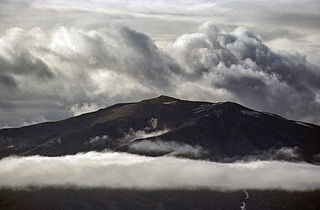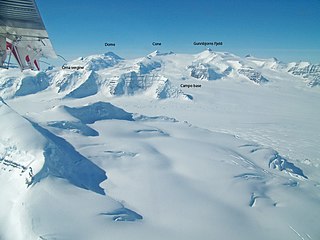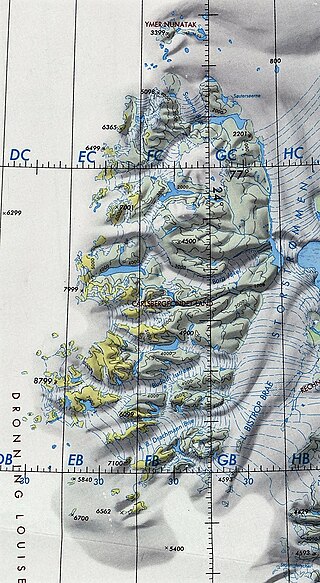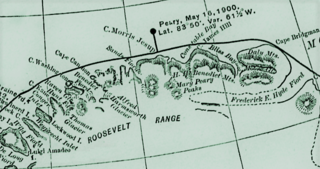North Ice was a research station of the British North Greenland Expedition on the inland ice of Greenland. The coordinates of the station were 78°04′N38°29′W, at an altitude of 2,341 metres (7,680 ft) above sea level. The British North Greenland Expedition had its main base camp in Britannia Lake, Queen Louise Land. It was led by Commander James Simpson RN. The station recorded a temperature of −66.1 °C (−87.0 °F) on 9 January 1954, which made it the lowest temperature ever recorded in North America up until that time. It was superseded by an observation of −69.6 °C (−93.3 °F) at the Greenland Ice Sheet on 22 December 1991. The name of the station contrasts to the former British South Ice station in Antarctica.

The British North Greenland expedition was a British scientific mission, led by Commander James Simpson RN, which lasted from July 1952 to August 1954. A total of 30 men took part, though not all stayed for both years.
Commander Cortlandt James Woore Simpson, CBE, DSC, PM was an English polar explorer and naval officer.

Andrée Land is a peninsula in King Christian X Land, East Greenland that is bounded by Kejser Franz Joseph Fjord, Isfjord and Geologfjord.
Lindhard Island is an uninhabited island of NE Greenland.

The Watkins Range is Greenland's highest mountain range. It is located in King Christian IX Land, Sermersooq municipality.
Storstrommen, is one of the major glaciers in northeastern Greenland. The North-East Greenland Ice Stream (NEGIS) discharges into 3 main marine-terminating outlets: 79N Glacier, Zachariae Isstrøm and Storstrommen - as arranged North to South.

King Frederick VIII Land is a major geographic division of northeastern Greenland. It extends above the Arctic Circle from 76°N to 81°N in a North-South direction along the coast of the Greenland Sea.

Queen Louise Land is a vast mountainous region located west of Dove Bay, King Frederick VIII Land, northeastern Greenland. Administratively it is part of the Northeast Greenland National Park zone.

Gefiontinde is the highest mountain in Queen Louise Land, NE Greenland. The peak is located in the King Frederick VIII Land area of northeastern Greenland. Administratively it is part of the Northeast Greenland National Park zone.

Academy Glacier, is one of the major glaciers in northern Greenland.

The Denmark expedition, also known as the Denmark Expedition to Greenland's Northeast Coast, and as the Danmark Expedition after the ship, was an expedition to the northeast of Greenland in 1906–1908. Despite being overshadowed by the death in tragic circumstances of the main exploration team, including three of the expedition's leading members: Ludvig Mylius-Erichsen (1872–1907), Niels Peter Høeg Hagen (1877–1907) and Jørgen Brønlund (1877–1907), the Denmark expedition was not a failure. It achieved its main cartographic objectives and succeeded in exploring the vast region, drawing accurate charts of formerly unexplored coastlines and fjords, naming numerous geographic features, and gathering a wealth of scientific data.

The Roosevelt Range or Roosevelt Mountains is a mountain range in Northern Greenland. Administratively this range is part of the Northeast Greenland National Park. Its highest peak is the highest point in Peary Land.

Sif Glacier, is a glacier in northern Greenland. Administratively it belongs to the Northeast Greenland National Park.
Kjerulf Fjord is a fjord in King Christian X Land, eastern Greenland.

Flade Isblink is an ice cap on the Crown Prince Christian Land peninsula, King Frederick VIII Land, NE Greenland.

Britannia Lake, is a lake in King Frederick VIII Land, Northeastern Greenland. The lake and its surroundings are part of the Northeast Greenland National Park zone.

Britannia Glacier is a glacier in Queen Louise Land, northeastern Greenland. Administratively it belongs to the Northeast Greenland National Park.

Ymer Nunatak is a nunatak in the Queen Louise Land area of northeastern Greenland. Administratively it is part of the Northeast Greenland National Park zone.

Ad Astra Ice Cap is an ice cap in Queen Louise Land, northeastern Greenland. Administratively it belongs to the Northeast Greenland National Park.















